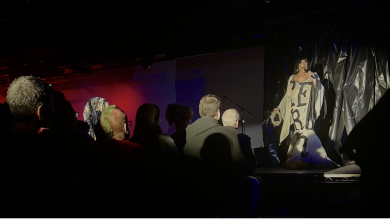The Anatomy of an Outfit: Dress Code Politics at UCLA

Photo courtesy of Gisselle Horta.
Aneri Suthar’s father thought her blue lace halter-top was too revealing, so he took a pair of scissors and ripped the shirt to shreds.
Suthar, now a first-year pre-human biology and society student, was not surprised. She already had a morning routine: leave the house in some variation of a baggy t-shirt and gym shorts, then slip into the high school bathroom before class to change into the outfit she’d hidden in her backpack.
Now, Suthar feels liberated by the absence of a dress code at UCLA and intends to take full advantage of her aesthetic freedom.
“The majority of my life I had to fight tooth and nail with my dad to say ‘Hey, shoulders aren’t sexual. I should be allowed to wear tank tops in 80 degree heat,’” Suthar said. “Now I don’t owe anyone an explanation and there’s no one stopping me.”
Suthar is one of many UCLA students who attend class in outfits that might be deemed inappropriate by traditional standards, destabilizing the deeply entrenched conservative logic that the female body does not belong in spaces of learning.
The oppressive idea that a woman cannot be simultaneously sexual and intelligent is ingrained into our culture’s dress codes, both written and implicit. This applies regardless of whether the woman intends to express sexuality — for example, a woman wearing a tanktop on a hot day might be perceived as a sexual object, thus hindering society’s ability to see her as anything but that. In one example, U.S. law firm Clifford Chance circulated a memo among its female employees that advised them to dress modestly, claiming “No one heard Hillary the day she showed cleavage.”
Suthar hopes to challenge this misogynistic dichotomy by displaying her intelligence in academic settings while wearing her favorite crop tops, shorts and dresses. “I’m going to be so smart when I speak that people aren’t even going to notice what I’m wearing,” Suthar said.
For first-year psychobiology student Lexie Yamada, showing skin in the classroom is less of a political statement and more of an aesthetic choice. She said she is drawn to clothing with cutouts, mesh and open backs, which show off the large tattoo on her upper back.
Yamada rejects the heterosexist argument that women’s revealing clothing can distract male students in the classroom, a form of slut shaming that perpetuates rape culture. “If you can’t focus, that’s your problem,” she said. “This isn’t the 1980’s.”
Yamada thinks the UCLA community is particularly accepting of showing skin on campus due to the relatively warm weather. In her hometown of Seattle, people might be confused by her summery style, she said.
Gisselle Horta, first-year psychology student, agrees that the campus is generally lax about clothing and said she rarely feels uncomfortable wearing shorts and crop-tops that show her midriff in lecture. She has never received any stares or comments about her clothing, and she feels she blends into the background.
Horta admitted, however, that she sometimes hesitates before leaving her dorm room in more revealing outfits. Both she and Suthar would choose more modest clothing in a professional setting like an interview for a job or a student club in fear of judgment.
Regardless of how much we embrace stylistic choice as a form of feminist empowerment, the reality of our patriarchal society limits our liberation. Fashion choices that deviate from gender norms can still result in tangible discrimination, like getting fired from a job or being denied employment. Unspoken and written dress codes are constructed by a white, heterosexist understanding of professionalism, heightening the risk of discrimination for trans people and people of color. The body shaming inherent in rigid dress codes can also result in discrimination against bodies that deviate from the thin “ideal.” For example, clothing that might be deemed “appropriate” on a person with small breasts could attract negative attention on a person with big breasts, cultivating shame and a sense that breasts or curves are things that need to be hidden.
Even relatively liberal UCLA perpetuates body policing and de facto dress standards that disproportionately burden women. Hailey Black, a first-year pre-human biology and society student, was forced to leave De Neve dining hall in April because her outfit — a cover-up worn over a one-piece bathing suit — was deemed inappropriate by dining hall employees. Black was told her outfit violated the simple “No shirt, no shoes, no service,” policy in residential facilities because her cover-up did not qualify as a shirt, despite the fact that her clothing did not expose her breasts or midriff. To add insult to injury, the Dining Services manager offered the victim-blaming explanation that the policy, which is written as gender-neutral, exists to protect women from sexual assault.
Suthar, Yamada and Horta’s individual displays of resistance are up against years of systematic sexualization, marginalization, and expressions of revulsion toward bodies that are not cis-male.
Suthar recalls one of several occasions when her father saw a full-figured person on the street in leggings, turned to his family and said, “That should be outlawed. I don’t want to see that.”
“There was such a sense of toxic masculinity and disgust,” Suthar said. “It was so hard to open up a conversation with him about why that makes him angry. [These rules are] just so ingrained and internalized.”
All three girls said they get a confidence boost from clothing that showcases their bodies and hope others will approve of their style. This is a fully valid sentiment and women must be allowed to find power in our sexuality and appearance. Nevertheless, it raises the concern that postfeminist narratives of empowerment through aesthetics are merely another way women have internalized the male gaze that contributes to our oppression.
In other words, women’s sexual expression should be authentic, not compulsively motivated by the idea that her body is the most important asset she has. After decades of misogynistic dress codes that beat out women’s personal preferences in favor of social norms, it can be hard to distinguish the two.
“Whether [my personal style] is performing femininity or because I genuinely enjoy the process I still don’t know,” Suthar said. “I don’t think I can ever get an objective answer to that.”
Regardless, embracing personal style can chip away at the social dress standards that remain encoded in our culture even after formal codes are removed from the books. It may take time before women regain authentic personal and institutional autonomy over our bodies, but the only way to achieve it is to dress as if we’re already there.




